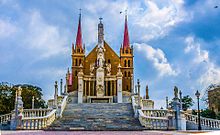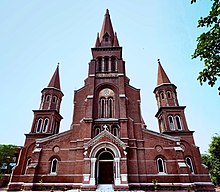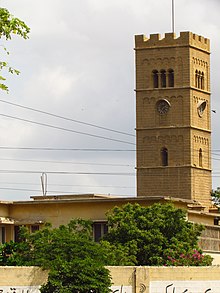
Dalit theology is a branch of Christian theology that emerged among the Dalit caste in the Indian subcontinent in the 1980s. It shares a number of themes with Latin American liberation theology, which arose two decades earlier, including a self-identity as a people undergoing Exodus. Dalit theology sees hope in the "Nazareth Manifesto" of Luke 4, where Jesus speaks of preaching "good news to the poor ... freedom for the prisoners and recovery of sight for the blind" and of releasing "the oppressed."
The Punjabis, are an Indo-Aryan ethnolinguistic group associated with the Punjab region, comprising areas of eastern Pakistan and northwestern India. They generally speak Standard Punjabi or various Punjabi dialects on both sides.
Persecution of Christians in the post–Cold War era refers to the persecution of Christians from 1989 to the present. Part of a global problem of religious persecution, persecution of Christians in this era is taking place in Africa, the Americas, Europe, Asia and Middle East.
The term Dalit Christian or Christian Dalit is used to describe those who have converted to Christianity from other forms of religion in the Indian subcontinent, and are still categorised as Dalits in Hindu, Christian, Muslim, and Sikh societies in South Asia. Hindu Dalits are sometimes referred to as Harijans. About 90% of Pakistani Christians are Dalits from the Chuhra caste and at least 9% of Indian Christians are Dalits, categorised thus by the greater societal practices in various parts of the Indian subcontinent.
Pakistan has five major ethno-regional communities in Pakistan: Baloch, Muhajir, Punjabis, Pushtuns and Sindhis, as well as several smaller groups. There are also religious and sectarian groups such as Ahmadis, Christians, Hindus, Kalasha, Parsis and Sikhs, and Shia Muslim sects including Ismailis and Bohras.
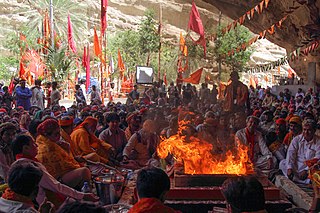
Hinduism is the second largest religious affiliation in Pakistan after Islam. While Hinduism was one of the dominant faiths in the region a few centuries back, today Hindus account for only 2.14% of Pakistan's population or about 4.4 million people according to the 2017 Pakistani census. The Umerkot district has the highest percentage of Hindu residents in the country at 52.2%, while Tharparkar district has the most Hindus in absolute numbers at 714,698.
Chuhra, also known as Bhanghi and Balmiki, is a Dalit caste in India and Pakistan. Populated regions include the Punjab region of India and Pakistan, as well as Uttar Pradesh in India, among other parts of the Indian subcontinent such as southern India. Their traditional occupation is sweeping, a "polluting" occupation that caused them to be considered untouchables in the caste system.

The official religion of Pakistan is Islam, as enshrined by Article 2 of the Constitution, and is practised by approximately 96.47% of the country's population. The remaining 3.53% practice Hinduism, Christianity, Ahmadiyya Islam, Sikhism and other religions.

The situation of Human Rights in Pakistan is complex as a result of the country's diversity, large population, its status as a developing country and a sovereign Islamic democracy with a mixture of both Islamic and secular law.

The Catholic Church in Pakistan is part of the worldwide Catholic Church, under the spiritual leadership of the pope in Rome.
The caste system among South Asian Christians often reflects stratification by sect, location, and the caste of their predecessors. There exists evidence to show that Christian individuals have mobility within their respective castes. But, in some cases, social inertia caused by their old traditions and biases against other castes remain, causing caste system to persist among South Asian Christians, to some extent. Christian priests, nuns, Dalits and similar groups are found in India, Pakistan, Bangladesh, and Nepal.
Sectarian violence in Pakistan refers to violence directed against people and places in Pakistan motivated by antagonism toward the target's religious sect. As many as 4,000 Shia are estimated to have been killed in sectarian attacks in Pakistan between 1987 and 2007, and thousands more Shia have been killed by Sunni extremists from 2008 to 2014, according to Human Rights Watch (HRW). Sunni Deobandis and Barelvis have also suffered from some sectarian violence, with attacks on religious shrines killing hundreds of worshippers, and some Deobandi leaders assassinated. Pakistan minority religious groups, including Hindus, Ahmadis, and Christians, have "faced unprecedented insecurity and persecution" in at least two recent years, according to Human Rights Watch. One significant aspect of the attacks in Pakistan is that militants often target their victims places of worship during prayers or religious services in order to maximize fatalities and to "emphasize the religious dimensions of their attack".
Christians form 1.3% of the total population numbering around 3.5 lakhs in Punjab, India as per as 2011 census. According to many media reports, demographic experts and Christian groups, there may be up to 2.77 million Christians living in Punjab, constituting up to 15% of the state population, although the authenticity of that claim is still not known. Many converts to Christianity keep their original identity to exploit the benefits of reservation. John Lowrie and William Reed were missionaries who went there in 1834. The Diocese of Amritsar of the Church of North India has its seat in Punjab as does the Roman Catholic diocese of Jalandhar. There are thousands of settlements with a Christian congregation. From 1881 to 1891 the Christian population of the then still united Punjab increased rapidly.

Catholic (National) Commission for Justice and Peace (NCJP) was formed in 1985 by the Catholic Bishops' Conference of Pakistan. It provides services in the field of human rights advocacy.
Christianity is the second largest religion in Punjab Province of Pakistan comprising 2.3% of its population. Most Christians (81%) of Pakistan live in Punjab province. There are 2,068,233 Christians in Punjab province as of 2017, up from 1,699,843 in 1998.
Persecution of Christians in Pakistan has been recorded since the country's independence in 1947. The persecution has taken many forms, including violence, discrimination, and blasphemy laws.
Religious discrimination in Pakistan is a serious issue for the human rights situation in modern-day Pakistan. Hindus, Christians, Sikhs, Shias, and Ahmadis among other religious minorities often face discrimination and at times are even subjected to violence. In some cases Christian churches and the worshippers themselves have been attacked. Khawaja Nazimuddin, the 2nd Prime Minister of Pakistan, stated: "I do not agree that religion is a private affair of the individual nor do I agree that in an Islamic state every citizen has identical rights, no matter what his caste, creed or faith be".

Punjabi Christians are adherents of Christianity who identify ethnically, linguistically, culturally, and genealogically as Punjabis. They are mainly found in the Pakistani province of Punjab, forming the largest religious minority. They are one of the four main ethnoreligious communities of the Punjab region with the others being Muslims, Sikhs and Hindus. Punjabi Christians are traditionally divided into various castes, and are largely descendants of Hindus who converted to Christianity during the British Raj in colonial India.
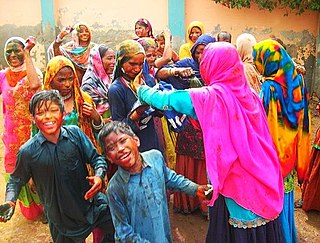
Hinduism is a minority religion in Punjab province of Pakistan followed by about 0.2% of its population. Punjab has the second largest number of Hindus in Pakistan after Sindh. Hinduism is followed mainly in the Southern Punjab districts of Rahim Yar Khan and Bahawalpur.
In the Jaranwala church arsons, 26 Christian churches in Jaranwala, Punjab, Pakistan were burnt down by acts of arson, and homes belonging to Christian families were looted and destroyed by Muslim rioters on August 16, 2023; Bible desecration was committed as well. The attacks were carried out by mobs of Muslims who were enraged by allegations that a Christian man had desecrated the Quran. No deaths were reported. More than a hundred rioters, that included members of the far-right group Tehreek-e-Labbaik, have since been arrested.

